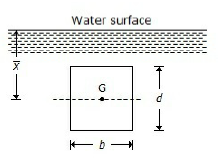The error in discharge (dQ/Q) to the error in measurement of head (dH/H) over a triangular notch is given by
dQ/Q = 3/2 × (dH/H)
dQ/Q = 2 × (dH/H)
dQ/Q = 5/2 × (dH/H)
dQ/Q = 3 × (dH/H)
Correct Answer :
C. dQ/Q = 5/2 × (dH/H)
Related Questions
The critical depth for a channel is given by (where q = Unit discharge (discharge per unit width) through the channel)
(q/g)1/2
(q²/g)1/3
(q³/g)1/4
(q⁴/g)1/5
A tank of uniform cross-sectional area (A) containing liquid upto height (H1) has an orifice of cross-sectional area (a) at its bottom. The time required to empty the tank completely will be
(2A√H₁)/(Cd × a√2g)
(2AH₁)/(Cd × a√2g)
(2AH₁3/2)/(Cd × a√2g)
(2AH₁²)/(Cd × a√2g)
The value of coefficient of discharge is __________ the value of coefficient of velocity.
Less than
Same as
More than
None of these
The unit of kinematic viscosity in S. I. units is
N-m/s
N-s/m2
m2/s
N-m
If the coefficient of discharge is 0.6, then the discharge over a right angled notch is
0.417 H5/2
1.417 H5/2
4.171 H5/2
7.141 H5/2
Gradually varied flow is
Steady uniform
Non-steady non-uniform
Non-steady uniform
Steady non-uniform
The unit of surface tension is
N/m
N/m2
N/m3
N-m
According to Bazin's formula, the discharge over a rectangular weir is mL2g x H3/2where m is equal to
0.405 + (0.003/H)
0.003 + (0.405/H)
0.405 + (H/0.003)
0.003 + (H/0.405)
Coefficient of velocity is defined as the ratio of
Actual velocity of jet at vena contracta to the theoretical velocity
Area of jet at vena contracta to the area of orifice
Actual discharge through an orifice to the theoretical discharge
None of the above
With an increase in size of tube, the rise or depression of liquid in the tube due to surface tension will
Decrease
Increase
Remain unchanged
Depend upon the characteristics of liquid
A model of torpedo is tested in a towing tank at a velocity of 25 m/sec. The prototype is expected to attain a velocity of 5 m/sec. What model scale has been used?
1 : 5
1 : 2.5
1 : 25
1 : √5
The Euler's equation for the motion of liquids is based upon the assumption that
The fluid is non - viscous, homogeneous and incompressible
The velocity of flow is uniform over the section
The flow is continuous, steady and along the stream line
All of the above
Euler's number is the ratio of __________ force to pressure force.
Inertia
Gravity
Viscous
None of these
For measuring flow by a Venturimeter, if should be installed in
Vertical line
Horizontal line
Inclined line with flow downward
In any direction and in any location
The specific weight of sea water is __________ that of pure water.
Same as
Less than
More than
None of these
When an internal mouthpiece is running free, the discharge through the mouthpiece is: (where a = Area of mouthpiece, and H = Height of liquid above the mouthpiece)
0.5 a. √2gH
0.707 a. √2gH
0.855 a. √2gH
a. √2gH
In an internal mouthpiece, if the jet after contraction does not touch the sides of the mouthpiece, then the mouthpiece is said to be
Running full
Running free
Partially running full
Partially running free
The viscosity of water at 20°C is
One stoke
One centistoke
One poise
One centipoise
Gauge pressure at a point is equal to the absolute pressure __________ the atmospheric pressure.
Plus
Minus
Divide
Multiply
Surface tension has the units of
Newton-sec/m
Newton-m/sec
Newton/m
Newton
A vertically immersed surface is shown in the below figure. The distance of its centre of pressure from the water surface is 
(bd²/12) + x
(d²/12 x) + x
b²/12 + x
d²/12 + x
The units of kinematic viscosity are
Metres² per sec
kg sec/metre
Newton-sec per metre
Newton-sec per metre
The coefficient of discharge for an external mouthpiece depends upon
Velocity of liquid
Pressure of liquid
Area of mouthpiece
Length of mouthpiece
The Newton's law of resistance is based on the assumption that the
Planes of the body are completely smooth
Space around the body is completely filled with the fluid
Fluid particles do not exert any influence on one another
All of the above
Uniform flow occurs when
The direction and magnitude of the velocity at all points are identical
The velocity of successive fluid particles, at any point, is the same at successive periods of time
The magnitude and direction of the velocity do not change from point to point in the fluid
The fluid particles move in plane or parallel planes and the streamline patterns are identical in each pleasure
The normal stress in a fluid will be constant in all directions at a point only if
It is incompressible
It has uniform viscosity
It has zero viscosity
It is at rest
The unit of viscosity is
Metres² per sec
kg-sec/metre
Newton-sec per metre²
Newton-sec per meter
Which of the following is the unit of kinematic viscosity?
Pascal
Poise
Stoke
Faraday
The velocity at which the laminar flow stops, is known as
Velocity of approach
Lower critical velocity
Higher critical velocity
None of these
When a body, floating in a liquid, is given a small angular displacement, it starts oscillating about a point known as
Centre of pressure
Centre of gravity
Centre of buoyancy
Metacentre
